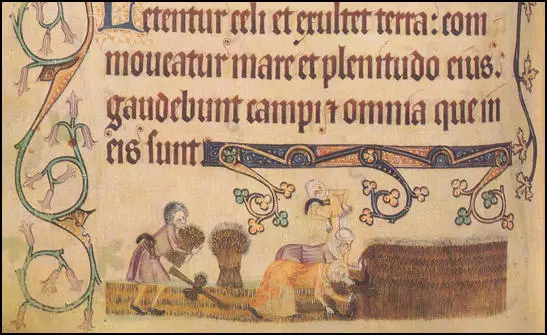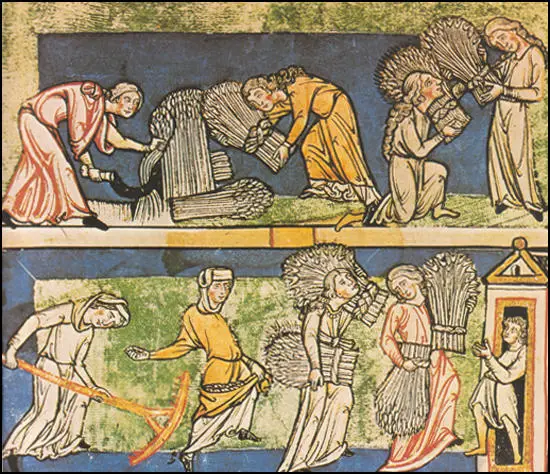Women in the Village Economy
Serfs had to provide around three days of work on the lord's land. They also had to provide boon work that consisted of extra labour which might be demanded at any time. "It was the most disliked of the two, and the harder to get free from, since it came at times, such as harvest and sheep shearing, when the serf's work was most needed both on the lord's domain and on his own land." As a result it was the women who had to look after the family crops. (1)
Women not only laboured in the fields. They did most of the sheepshearing and were usually in charge of the garden where they grew vegetables and kept a few chickens. Women also made the cloth, cooked the food, and looked after the children. "Women worked in the fields at gleaning, turnip-pulling, hoeing, weeding and in all kinds of fruit and vegetable picking. In some jobs the children worked alongside their mothers." (2)
As Rosalind Miles, the author of The Women's History of the World (1988), has pointed out: "Women everywhere tended their children, milked their cattle, tilled their fields, washed, baked, cleaned and sewed, healed the sick, sat by the dying and laid out the dead... While there was work to be done, women did it, and behind the vivid foreground activities of popes and kings, wars and discoveries, tyranny and defeat, working women wove the real fabric of the kind of history that has yet to receive its due". (3)

As well as supplying the needs of their families, women were often involved in producing goods for sale. It was they rather than men who were more likely to produce bread, beer or clothes to be sold to other members of the village. "If the husband has sheep of his own, then his wife may have some of the wool, to make her husband and herself some clothes... she may also take wool to spin for the cloth makers. That way she can earn her own living, and still have plenty of time to do other work." (4)
On the death of her husband, a woman was entitled by law to take over a third of his holding. In some villages, women who were able to pay the entry fees to the lord, were allowed to carry on farming all the land. However, it is clear from looking at "contemporary documents, that no woman was expected to remain long unmarried, and both legislation and local custom assumed marriage as the natural state for everyone of mature age." (5)

Despite the fact that women contributed so much to the village economy they did not have the same rights as men in the village. For example, women were not allowed to be appointed to official posts such as bailiff, reeve, constable or aletaster. These were all jobs that went to the men in the village. (6)
Primary Sources
(1) Details of labour services at Frochester Manor (1265)
Margery, the widow, holds 24 acres and she pays 3s every year... From Michaelmas to the Feast of St Peter she must plough half an acre every week... And from the Feast of St John the Baptist until August she must perform manual service 3 days every week... She shall mow the lord's meadow for at least 4 days... And she must lift the lord's hay for at least 4 days... She shall weed 2 days... And from the Feast of St Peter until Michaelmas she must perform manual service 5 days a week... And furthermore she performs 8 boon works in autumn... And she shall give eggs at Easter at will.
(2) Christine de Pisan, Three Virtues (1406)
She (the lady of the manor) should be a good manager, knowledgeable about farming, knowing in what weather and in what season the fields should be worked... She should often take her recreation in the fields in order to see how the work is progressing, for there are many who would willingly stop raking the ground beyond the surface if they thought nobody would notice.
(3) William FitzHerbert, Book of Husbandry (c. 1140)
If the husband has sheep of his own, then his wife may have some of the wool, to make her husband and herself some clothes... she may also take wool to spin for the cloth makers. That way she can earn her own living, and still have plenty of time to do other work... It is the wife's occupation to winnow corn, to make malt, to wash clothes, to make hay and to cut corn. In time of need she should help her husband fill the dung-cart, drive the plough, and load the hay and corn. She should also go to the market to sell butter, cheese, milk, eggs, chickens, pigs, geese and corn. And also to buy the things needed for the household.
(4) Rosalind Miles, The Women's History of the World (1988)
Women everywhere tended their children, milked their cattle, tilled their fields, washed, baked, cleaned and sewed, healed the sick, sat by the dying and laid out the dead... The extraordinary continuity of women's work, from country to country and age to age, is one of the reasons for its invisibility; the sight of a woman nursing a baby, stirring a cook-pot or cleaning a floor is as natural as the air we breathe... While there was work to be done, women did it, and behind the vivid foreground activities of popes and kings, wars and discoveries, tyranny and defeat, working women wove the real fabric of the kind of history that has yet to receive its due.
(5) Chris Harman, A People's History of the World (2008)
Ruling class women were increasingly treated as an ornament, a source of sexual pleasure or as a breeder of heirs. They would be protected from hardship and external dangers, but also cocooned from any interaction with the wider social world. Life was very different for women in agricultural or artisan households. They still had a productive role and were engaged in endless toil. Nevertheless, it was their husbands who controlled relations between the household and the rest of society, imposing on the women and children the measures needed to ensure the household's survival (including successive pregnancies for the wife).
(6) H. S. Bennett, The Pastons and their England (1922)
It is evident from a brief survey of contemporary documents, that no woman was expected to remain long unmarried, and both legislation and local custom assumed marriage as the natural state for everyone of mature age. Since in all feudal society the superiority of men was unquestioned, and popular opinion recognised marriage as inevitable, women very easily came to look on matrimony as part of the scheme of things. Probably the idea that a woman had a right to remain single, unless she entered the cloister and became the bride of Christ, or to select her own husband, was unthinkable at that time.
(7) J. F. C. Harrison, The Common People (1984)
Women were an essential part of the harvest team. But their work was not limited to the special effort required at that time of the year... Women worked in the fields at gleaning, turnip-pulling, hoeing, weeding and in all kinds of fruit and vegetable picking. In some jobs the children worked alongside their mothers.
(8) A. L. Morton, A People's History of England (1938)
The villeins... in the common fields, were the pivot around which the whole life of the manor revolved. Their services were regularised and most often increased after the Norman Conquest. They were of two kinds: day work, and boon work. Day work was performed on a regular number of days a week, usually three. Boon work consisted of extra labour which might be demanded at any time. It was the most disliked of the two, and the harder to get free from, since it came at times, such as harvest and sheep shearing, when the serf's work was most needed both on the lord's domain and on his own land. It is clear from the amount of labour services due from the villein that the bulk of the work in his own holding must have been performed by the other members of his family.
Student Activities
The Medieval Village Economy (Answer Commentary)
Women and Medieval Farming (Answer Commentary)
Contemporary Accounts of the Black Death (Answer Commentary)
Disease in the 14th Century (Answer Commentary)
King Harold II and Stamford Bridge (Answer Commentary)
The Battle of Hastings (Answer Commentary)
William the Conqueror (Answer Commentary)
The Feudal System (Answer Commentary)
The Domesday Survey (Answer Commentary)
Thomas Becket and Henry II (Answer Commentary)
Why was Thomas Becket Murdered? (Answer Commentary)
Illuminated Manuscripts in the Middle Ages (Answer Commentary)
